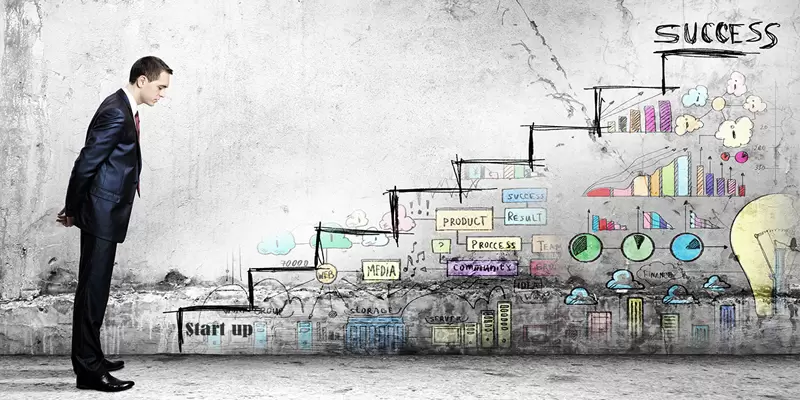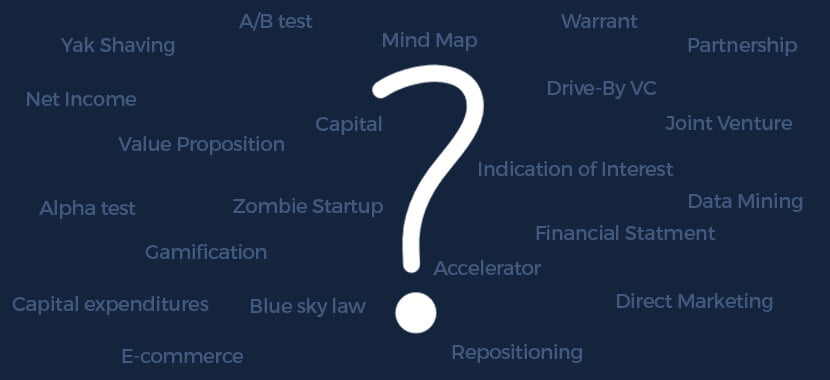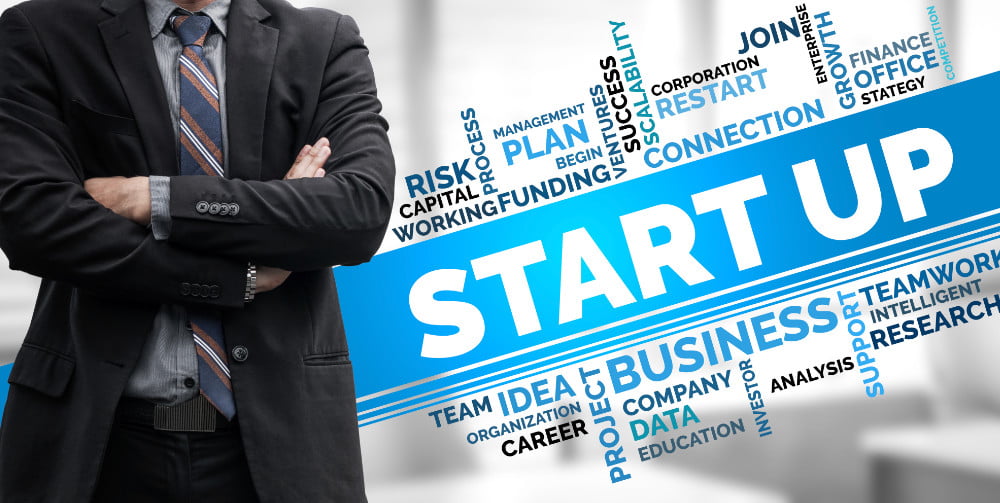
YD News/ startup terms every entrepreneur should know/ Four minutes read
Startup terms for every Entrepreneur
If you are planning to start a startup business. To present your business plan, you should be familiar with the use of terminology in the industry. These are the jargon words.
The best entrepreneurs, technical or non-technical, may not have expertise in everything. they are able to wear many hats and speak many languages. It has the finance team, programmers, designers, marketers, business developers, or other areas.
Check the list down below of startup jargon that every aspiring entrepreneur should know. Jargon words are like special words or expressions. It is highly used by professionals or groups that are difficult for others to understand.

1 – Business Startup terms
Founder
The one who creates a site and business cards and claims to be the founder of a startup. A true entrepreneur is an implementer and founders are the ones who take action.
Wantrepreneur
The wantrepreneurs have a bundle of ideas. Like they develop startup apps. And there is no need for technical or non-technical knowledge. Wantrepreneurs always planning to execute things.
Non-technical
Technology startups consist of technical and non-technical founders. Technical founders have a programming background and Non-technical founders are business and marketing professionals.
Validation
There are many indicators for idea validation. it comes down to demonstrating that there is a need and demand for the product. People pay for a product, use it, and recommend it to others with similar needs. This is one of the strongest validation signals.
Scalability
With advances in technology and automation, a startup product can serve hundreds of thousands of users. It doesn’t require the same number of service providers.
Accelerator
If you are launching a startup, accelerators can help you move your idea forward quickly and can provide mentorship and fundraising opportunities over the course of a few months.
Incubators
It provides mentorship, connections, and resources. Accelerators prioritize speed and fundraising. Earlier-stage startups are acceptable. And incubators assist them to overcome any early-stage challenges.
Unicorn
A unicorn is a startup that has a valuation of one billion dollars or more. These companies are known as unicorns.
Dragon
These are some smaller numbers of startups that raise over one billion dollars in one single round of funding. Those are called Dragons. For example, Uber is one of those companies.
Bootstrapping
Bootstrappers are entrepreneurs who use their own money and knowledge, experience, and skills to start and grow a business. It can be useful in the early stages as well. This path acts as helpful for the majority of founders.
Iteration
It works when you realize you need to make a minor change to the product. It can be the target buyer and any important aspect of the business model, you are iterating.
Disruption
When it comes to what investors look for in a startup, it’s founders who aim to create products and business models that introduce an innovation that makes a significant difference in the market and the world. Consider Uber, which has completely transformed how people commute.
MVP
To test ideas quickly without spending a lot of resources on building a product that may or may not work, entrepreneurs are encouraged to create a minimum viable product. It’s the first version of the product that only include the core features that aim to test the riskiest assumptions before building the next versions with more advanced features.
Lean
Minimum viable products are a component of the lean methodology, which entails going through the build-measure-learn loop, which essentially enforces the idea of building and testing quickly rather than building an advanced product and hoping for customers to come.
Exit
Entrepreneurs build startups for many reasons. Many want to make a major impact in the world while others, in addition to the impact, aim to exit their ventures either through an IPO or mergers and acquisitions.
SaaS
Software as a service (SaaS) is now one of the most common startup business models. This is when you create a product that includes features that customers can access through a subscription. Paying a monthly fee for hosting or using an email marketing platform.
Acqui-hire
Many established companies decide to acquire smaller firms or startups just for the human capital (team) they built. Such acquisitions are called acqui-hire.
Alpha release
Since continuous testing is important to the success of the software, teams run alpha tests internally early on before releasing the beta version of the product for public testing.
Beta release
Having conducted internal alpha tests, beta tests involve customers or potential users who provide feedback and help the team make changes before launch.
Board of directors
Mentorship, guidance, and connections are critical to a startup’s success. The board of directors typically includes members who can assist the founders in making more informed decisions while also contributing to areas such as hiring, business development, and fundraising.
Pitch deck
Most investors expect a quick presentation that highlights the key areas of a startup such as a team, product, market, traction, and plan before making an investment. For investor presentations, entrepreneurs create and use a pitch deck.
Value proposition
Business is about solving a problem for a customer by offering a solution that’s better or has unique benefits over the competition.
2. Marketing Startup Terms

Growth Hacking
A successful marketing campaign achieves its goal at a cost that is less than the return generated. Growth hackers employ unconventional strategies to drive exponential growth at significantly lower costs than the “average” amounts required to achieve the same results.
Evangelists
In the product adoption lifecycle, you find different categories of buyers adopting the product in different time periods. The evangelists are those who come early on, they are the first to believe in the product and convince others to adopt it.
SEO
Search engines such as Google and Yahoo are becoming increasingly important in the growth of a startup. Without them, a startup must continue to invest in paid advertising to gain new customers. Search engine optimization refers to the strategies and tactics used by businesses to improve their search engine rankings.
Target market
Your ideal buyers. A group of customers with similar needs and objectives. You can define your ideal customers through their demographics, psychographics, and other categories.
Inbound marketing
This is when you create valuable content for your ideal customers that ranks high in search engines and drives traffic to your website. Writing guides, creating educational videos and training, releasing podcast episodes, and creating infographics are all ways to deliver your content.
Outbound marketing
Inbound marketing necessitates a time investment, whereas outbound marketing necessitates a financial commitment because it entails paying platforms such as Facebook, Google, and LinkedIn to push your product to customers.
3. Analytics Startup Terms
KPI
It stands for key performance indicators, the metrics by which startups judge their performance, progress, and targets. Some of the most common KPIs include customer acquisition cost, customer lifetime value, and monthly and annual recurring revenue.
Bounce
An important metric that measures how long website visitors spend on the page before leaving. The goal is to have a low bounce rate meaning that the site content or features are worthy of visitors’ time.
A/B testing
To learn what might optimize important metrics, run a test with different variations such as a call to action or copy. These are known as A/B tests. Many platforms now allow you to run A/B tests with the click of a button.
LTV
Stands for the lifetime value of the customer. The basic formula to calculate LTV is multiplying the average revenue per account by gross margin and dividing the total by customer churn rate. Today, many platforms can help you calculate and project your LTV.
CAC
One of the most important metrics in business is the customer acquisition cost. In other words, how much does it cost you to acquire a customer? Without knowing this number, it is hard to budget marketing campaigns or make any projections.
4. Finance Startup Terms
Angel
If you are looking for funding for an idea, angel investors are the best groups to look for. Then, they tend to be individual investors, family, and friends looking to support and fund a promising venture at an early stage for a potentially high return.
VC
Unlike angels, most venture capitals invest for a living. Usually, they are interested in startups with traction and proof that an investment will help accelerate their path to goals.
Seed
Right after an angel round comes a seed round, although there is no required sequence to follow. Companies that receive a seed round tend to have found a viable business model with customers.
Cashflow
The amount of money flowing in and out of the business. Free cash flow is the amount left in the business after paying expenditures. Free cash flow is used as a profitability measure of the business.
5. Programming Startup Terms
Stack
In order to create a fully functional web or mobile application, programmers require a tech stack that includes programming languages, frameworks, tools, and databases. So, It is a list of technologies required to create and launch a functional application.
QA
Quality assurance tests are performed by teams to ensure that the developed application functions properly and meets expectations. There are numerous types of quality assurance tests. The tests that are chosen are determined by the application, stage, and other variables.
DevOps
To create faster and more efficient development cycles, DevOps is a practice that combines software development and IT operations.
Full-stack
Programmers that are proficient with coding both the back-end and front-end of an application are called full-stack developers.
Front-end
This is what the user sees when interacting with an application.
Framework
A software framework is similar to a library of code that can be used and integrations that can be used to simplify the development environment.
Concurrency
Concurrency allows programs to perform multiple tasks at the same time and which eventually improves speed and efficiency.
CRUD
A database application that uses multiple forms to enter and exit data from a database. It is an acronym that stands for create, read, update, and delete.
Cache
You may have websites that you visit frequently. Many of those sites use cache to store recently used information for easy access.
6. Design Startup Terms
User interface
The design of an application is seen by the user.
User experience
How designs of many pages and sections of an application synchronize to provide users with an experience that helps them solve the problem or accomplish the goal they use the application for.
Usability
Under the user experience umbrella, usability is the degree to which a product can be used effectively and efficiently allowing users to accomplish the desired outcome with maximum clarity of use.
Accessibility
Accessibility focuses on the ease of access to the app’s various pages and key features.
Also read, 5 Indian Startups that got a big investment in 2019
